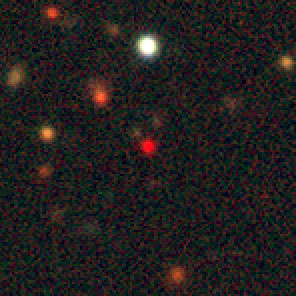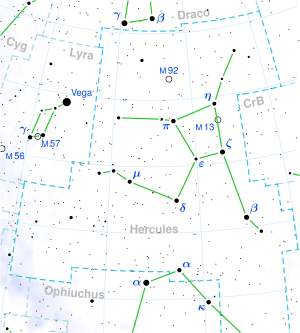Top Qs
Timeline
Chat
Perspective
WISEPA J174124.26+255319.5
Star in the constellation Hercules From Wikipedia, the free encyclopedia
Remove ads
WISEPA J174124.26+255319.5 (designation is abbreviated to WISE 1741+2553) is a brown dwarf of spectral class T9,[1][8] located in constellation Hercules at approximately 15.2 light-years from Earth.[3]
Remove ads
History of observations
Summarize
Perspective
Discovery
WISE 1741+2553 was discovered in 2011 from data, collected by Wide-field Infrared Survey Explorer (WISE) Earth-orbiting satellite—NASA infrared-wavelength 40 cm (16 in) space telescope, which mission lasted from December 2009 to February 2011. WISE 1741+2553 has three discovery papers: Scholz et al. (2011), Gelino et al. (2011) and Kirkpatrick et al. (2011).[7][9][1]
- Scholz et al. discovered two late T-type brown dwarfs, including WISE 1741+2553, using preliminary data release from WISE and follow-up near-infrared spectroscopy with LUCIFER1 near-infrared camera/spectrograph at the Large Binocular Telescope (LBT).
- Gelino et al. examined for binarity nine brown dwarfs using Laser Guide Star Adaptive Optics system (LGS-AO) on Keck II telescope on Mauna Kea; seven of these nine brown dwarfs were also newfound, including WISE 1741+2553. These observations had indicated that two of these nine brown dwarfs are binary, but the other seven, including WISE 1741+2553, are single brown dwarfs.
- Kirkpatrick et al. presented discovery of 98 new found by WISE brown dwarf systems with components of spectral types M, L, T and Y, among which also was WISE 1741+2553.[1][~ 1]
Remove ads
Distance
Currently the most accurate distance estimate of WISE 1741+2553 is a trigonometric parallax, measured using Spitzer Space Telescope and published in 2013 by Trent Dupuy and Adam Kraus: 0.180±0.015 arcsec, corresponding to a distance 5.6+0.5
−0.4 pc, or 18.1+1.6
−1.4 ly.[4]
Space motion
WISE 1741+2553 has proper motion of about 1553 milliarcseconds per year.[2]
See also
Another object, discovered by Scholz et al. (2011):[7]
- WISE 0254+0223 (T8)
The other eight objects, checked for binarity by Gelino et al. (2011) on Keck II:[9]
- binarity found:
- WISE 0458+6434 (T8.5 + T9.5, component A discovered before by Mainzer et al. (2011)[10])
- WISE 1841+7000 (T5 + T5, newfound)
- binarity not found:
- WISE 0750+2725 (T8.5, newfound[~ 2])
- WISE 1322-2340 (T8, newfound)
- WISE 1614+1739 (T9, newfound)
- WISE 1617+1807 (T8, discovered before by Burgasser et al. (2011)[11])
- WISE 1627+3255 (T6, newfound)
- WISE 1653+4444 (T8, newfound)
- List of nearest stars
- WISE 1541-2250 — Y0.5 object (44 light-years)
- UGPS 0722−05 — similar T9 object (13 light-years)
Remove ads
Notes
- These 98 brown dwarf systems are only among first, not all brown dwarf systems, discovered from data, collected by WISE: six discoveries were published earlier (however, also listed in Kirkpatrick et al. (2011)) in Mainzer et al. (2011) and Burgasser et al. (2011), and the other discoveries were published later.
- Presented in Gelino et al. (2011), but this is not mentioned in Kirkpatrick et al. (2011) and Kirkpatrick et al. (2012) — according to these two articles, the only discovery paper of WISE 0750+2725 is Kirkpatrick et al. (2011).
Remove ads
References
External links
Wikiwand - on
Seamless Wikipedia browsing. On steroids.
Remove ads


